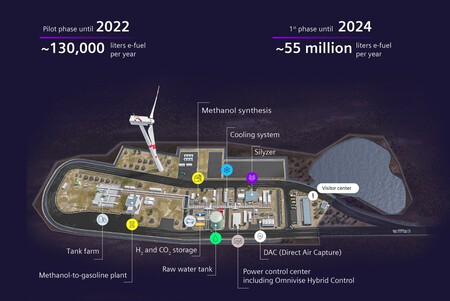Fuel made basically from water, wind and air. If all goes according to plan, in a matter of months, during the second half of 2022, the Haru Oni plant, located in southern Chile, will begin to generate what is known as e-Fuel with a clear purpose: to demonstrate that it is possible to create on a large scale, synthetic and green fuels valid for all types of vehicles, from cars to boats or planes. And thus facilitate, incidentally, the decarbonization and energy revolution.
Haru Oni is the result of the combined forces of the Chilean startup Highly Innovative Fuels and large multinationals from the energy sector and the technology and automotive industry, such as Siemens, Enel, Enap, Exxon, Porsche or Gasco. Its purpose is as ambitious as it is promising: to create one of the first plants dedicated to generating e-Fuels, which includes carbon-neutral gasoline and LPG. One of its promoters, Simenens, claims that once operational it will be the first commercial and integrated plant capable of generating on a large scale ecological fuel.
What matters most is how you will do it. Its raw materials will be water, wind and air. That and state-of-the-art technology, of course. Its mechanics is divided into four major phases. During the first, the plant captures carbon dioxide (CO2) and produces green hydrogen. CO2 is obtained from the atmosphere or industrial sources and hydrogen through a process called electrolysis, during which wind power is used to separate hydrogen and oxygen in water.
Fuel for cars, boats and planes
With these “ingredients” on the table, the Haru Oni plant faces the third phase: it combines green hydrogen and CO2 in a reactor and obtains the first eFuel, a material that, thanks to additional treatments, can be reconverted into e-Gasoline or sustainable aviation fuel (SAF). “e-Fuels can be used in the same cars, trucks, boats and planes as today, replacing fossil fuels. They release the same carbon dioxide that was initially captured and will be recaptured. A carbon recycling system,” argues HIF .
The fundamental role that wind power will play is precisely the reason why those responsible have decided to establish Haru Oni in Punta Arenas, in southern Chile, an area with strong currents and where they want to take advantage of the Magellanic wind. In total, its promoters calculate that 130,000 liters of eGasoline and 350 tons of crude eMethanol will be produced per year.
Siemens goes further and specifies the plant’s roadmap: in a pilot phase it calculates that 750,000 liters of e-Methanol will be generated per year —an objective that it already sets for this year on its website—, which will partly be used for the production of e-Gasoline. In the medium term, the goal will be much more ambitious: reach 55 million liters in 2024 and exceed 550 by 2026.

“Basically, anything that can be refined from crude oil could also be made this way,” Meg Gentle, executive director of HIF Usa, tells CNN, insisting that eFuels are not incompatible with the push for electric cars. .
The objective, he explains, is that both can coexist and synthetic fuel helps in the process of decarbonization and retirement of fossil fuels, both in private vehicles and those dedicated to transporting large loads, such as planes or ships. To achieve this, achieve large-scale productions that allow lower prices like the one Haru Oni poses will be crucial.

The plant in Chile will occupy an area of 3.7 hectares and will require an investment of between 51 and 55 million euros. The works started last summer and the company plans that its start-up and the delivery of the first e-Fuel will be ready in the second half of 2022.
Pictures | HIF Global and Siemens
George is Digismak’s reported cum editor with 13 years of experience in Journalism
